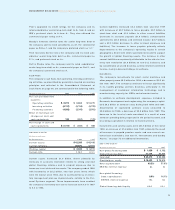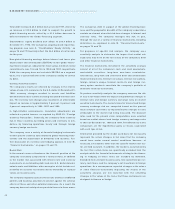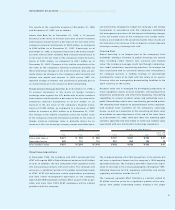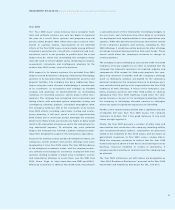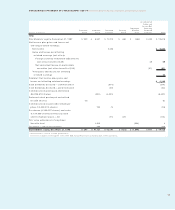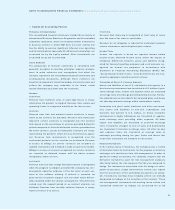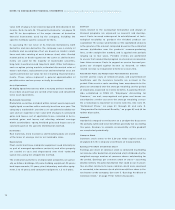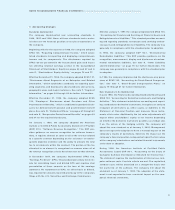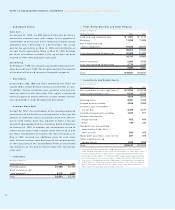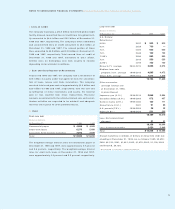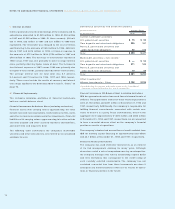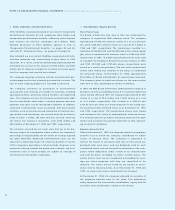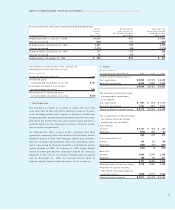IBM 1998 Annual Report Download - page 71
Download and view the complete annual report
Please find page 71 of the 1998 IBM annual report below. You can navigate through the pages in the report by either clicking on the pages listed below, or by using the keyword search tool below to find specific information within the annual report.
NOTES TO CONSOLIDATED FINANCIAL STATEMENTS International Business Machines Corporation and Subsidiary Companies
69
ASignificant Accounting Policies
Principles of Consolidation
The consolidated financial statements include the accounts of
International Business Machines Corporation and its controlled
subsidiary companies, which are majority owned. Investments
in business entities in which IBM does not have control, but
has the ability to exercise significant influence over operating
and financial policies (generally 20–50 percent ownership), are
accounted for by the equity method. Other investments are
accounted for by the cost method.
Use of Estimates
The preparation of financial statements in conformity with
generally accepted accounting principles requires manage-
ment to make estimates and assumptions that affect the
amounts reported in the consolidated financial statements and
accompanying disclosures. Although these estimates are
based on management’s best knowledge of current events and
actions the company may undertake in the future, actual
results ultimately may differ from the estimates.
Revenue
HARDWARE
Revenue from hardware sales or sales-type leases is recog-
nized when the product is shipped. Revenue from rentals and
operating leases is recognized monthly as the fees accrue.
SERVICES
Revenue from time and material service contracts is recog-
nized as the services are provided. Revenue from fixed price
long-term service contracts is recognized over the contract
term based on the percentage of services provided during the
period compared to the total estimated services provided over
the entire contract. Losses on fixed price contracts are recog-
nized during the period in which the loss first becomes appar-
ent. Revenue from maintenance is recognized over the
contractual period or as the services are performed. Revenue
in excess of billings on service contracts are recorded as
unbilled receivables and included in trade accounts receivable.
Billings in excess of revenue recognized on service contracts
are recorded as deferred income until the above revenue
recognition criteria are met.
SOFTWARE
Revenue from one-time charge licensed software is recognized
when the program is shipped, provided the company has ven-
dor-specific objective evidence of the fair value of each ele-
ment of the software offering. A deferral is recorded for
post-contract customer support and any other future deliver-
ables included within the contract arrangement. This deferral is
earned over the support period or as contract elements are
delivered. Revenue from monthly software licenses is recog-
nized as license fees accrue.
FINANCING
Revenue from financing is recognized at level rates of return
over the term of the lease or receivable.
Revenue for all categories is reduced for estimated customer
returns, allowances and anticipated price actions.
Income Taxes
Income tax expense is based on reported income before
income taxes. Deferred income taxes reflect the impact of
temporary differences between assets and liabilities recog-
nized for financial reporting purposes and such amounts rec-
ognized for income tax purposes. In accordance with
Statement of Financial Accounting Standards (SFAS) 109,
“Accounting for Income Taxes,” these deferred taxes are mea-
sured by applying currently enacted tax laws.
Translation of Non-U.S. Currency Amounts
Assets and liabilities of non-U.S. subsidiaries that operate in a
local currency environment are translated to U.S. dollars at year-
end exchange rates. Income and expense items are translated
at average rates of exchange prevailing during the year. Transla-
tion adjustments are recorded in Accumulated gains and losses
not affecting retained earnings within stockholders’ equity.
Inventories and plant, rental machines and other non-mone-
tary assets and liabilities of non-U.S. subsidiaries and
branches that operate in U.S. dollars, or whose economic
environment is highly inflationary, are translated at approxi-
mate exchange rates prevailing when acquired. All other
assets and liabilities are translated at year-end exchange
rates. Inventories charged to cost of sales and depreciation
are translated at historical exchange rates. All other income
and expense items are translated at average rates of
exchange prevailing during the year. Gains and losses that
result from translation are included in net income.
Financial Instruments
In the normal course of business, the company uses a variety
of derivative financial instruments for the purpose of currency
exchange rate and interest rate risk management. In order to
qualify for hedge accounting, the company requires that the
derivative instruments used for risk management purposes
effectively reduce the risk exposure that they are designed to
hedge. For instruments associated with the hedge of antici-
pated transactions, hedge effectiveness criteria also require
that the occurrence of the underlying transactions be proba-
ble. Instruments meeting these hedging criteria are formally
designated as hedges at the inception of the contract. Those
risk management instruments not meeting these criteria and
considered ineffective as hedges are accounted for at fair


